

Nikon SMZ 800/1000: excellent results at a reasonable price
Nikon’s SMZ 800 and SMZ 1000, both professional quality stereo microscopes, have parallel optical beam paths that impress users with their combination of modularity and quality. Both models are relatively low priced entry-level models that can be improved to achieve truly excellent results. Moreover, by making only minor enhancements, both are very capable for photographic use.
The best image quality is produced when using cameras with large sensors (DSLRs with full-frame or APS-C sensors). Using our LM microscope adapters, state-of-the-art cameras can be paired with Nikon’s SMZ series microscopes to attain the highest degrees of resolution, dynamic range and light sensitivity.
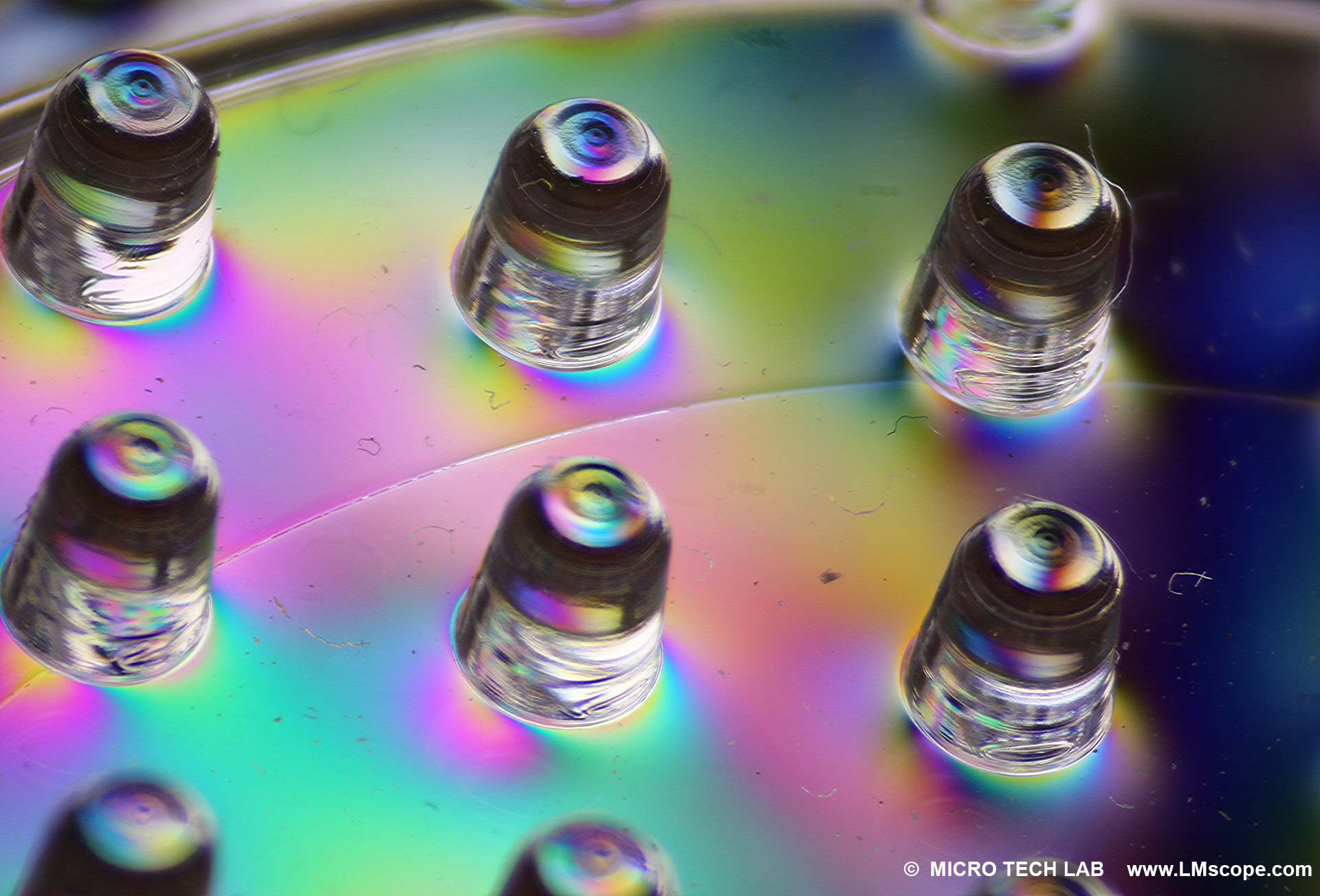
The SMZ 800 is equipped with an infinity-corrected optical system and incorporates a zoom ratio of 6.3 (the SMZ 1000 offers a 10x zoom factor with a zoom range of 0.8x to 8x). Depending on the eyepiece and the objective selected, this substantial zoom range offers total magnifications from 5x to 378x (SMZ 800) and 4x to 480x (SMZ 1000). For both instruments, illumination is provided by a 6 volt/30 watt halogen lamp. The zooming knob also features click stops that help setting the correct distance when zooming.
Eyepieces that offer a high eyepoint and wide field of view (C-W10x/22) come standard on these instruments. The ergonomic binocular tube, which can be tilted from 0 to 30º, contributes to an ergonomic seating position. Alternatively, a binocular tube with a 20º horizontal inclination and a tube with a low viewing height are available as well. Height can be adjusted to the operator’s eyepoint via intermediate tubes. Further, low-positioned operating elements, variable working distances and eyepieces (with field numbers from 7 to 22) with dioptre adjustment help configure the instrument to the operator’s individual needs.
A transmitted light stand and an epifluorescence module are also optional accessories.
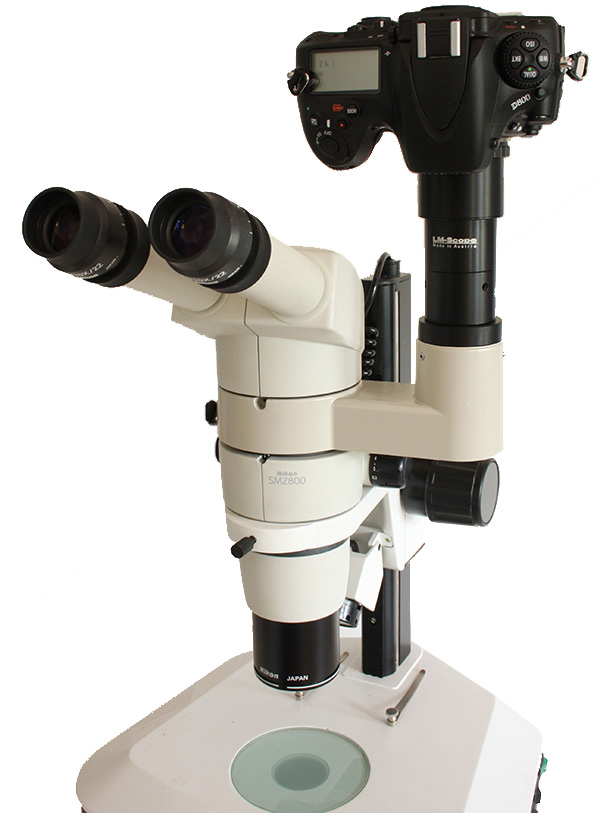
It is very easy to attach a DSLR or system camera to the SMZ 800 and SMZ 1000 microscopes by mounting a beam splitter between the zoom body and the binocular tube.
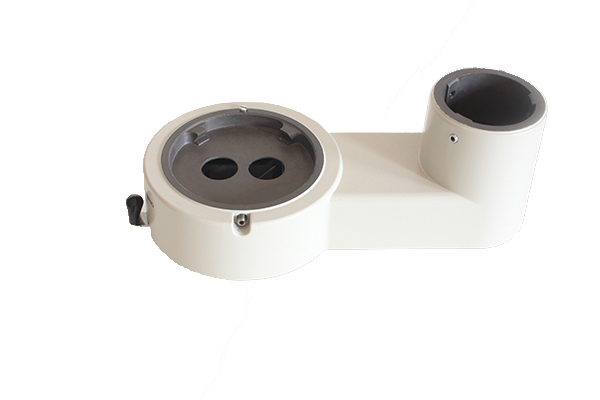
A C-mount port with a 1x factor is then attached directly to the beam splitter, to which the LM digital adapter and camera are attached. The splitting options are 100% observation/0% photo or 50% observation/50% photo.
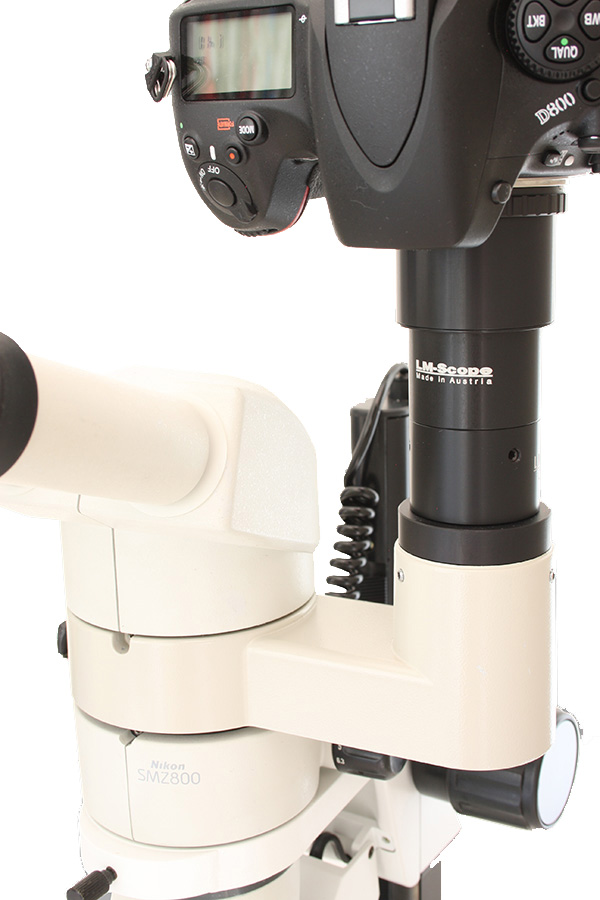
Of course, our LM adapter can also be mounted to the fixed tube.
The Nikon SMZ800 and SMZ1000 can also be equipped with the Nikon trinocular tube P2-TERGG.
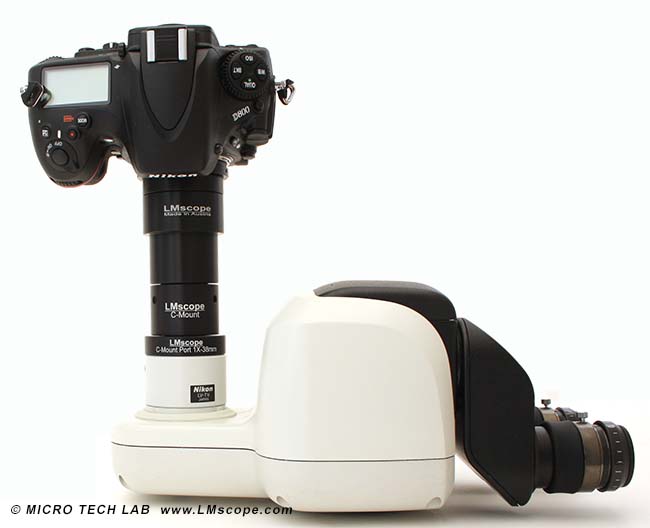
Following the original Nikon LT-TV adapter (white above) either the original Nikon video adapter A or our C-mount 1x adapter (TUST38C) is mounted. The main adapter with integrated optics is placed on top.
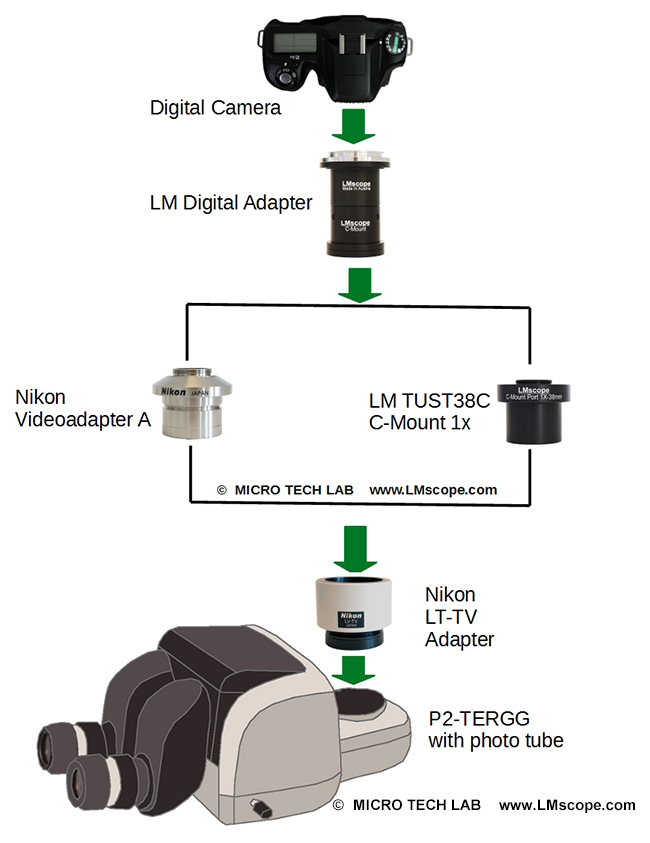
If there is no original LT-TV adapter available, we will be happy to offer you the appropriate C-mount connection (CMount1x_N_39mm). This is precisely matched to the photo tube.
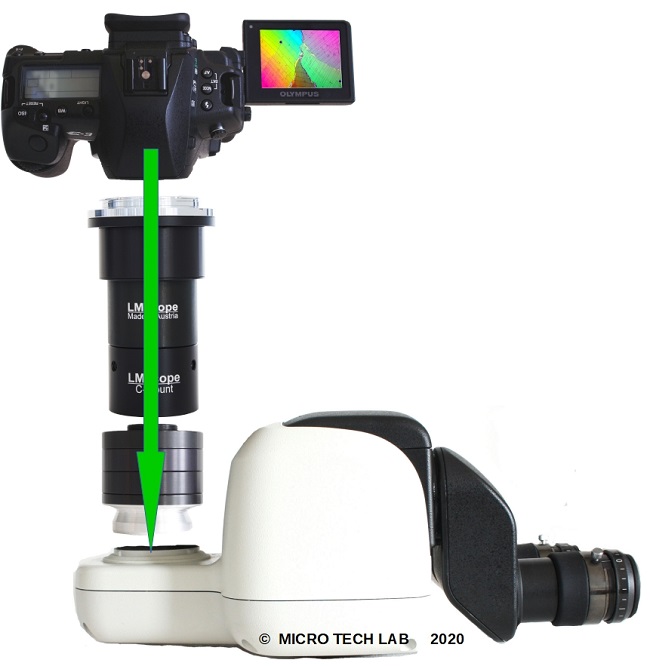
Nikon’s SMZ 800 and SMZ 1000 stereo microscopes are of the telescope type, which means that they have two parallel beam paths which pass through the common main objective.
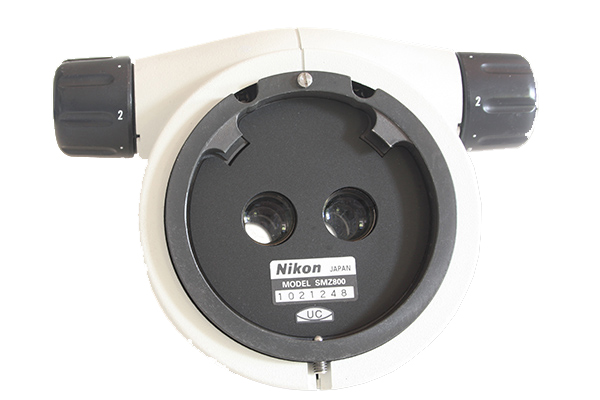
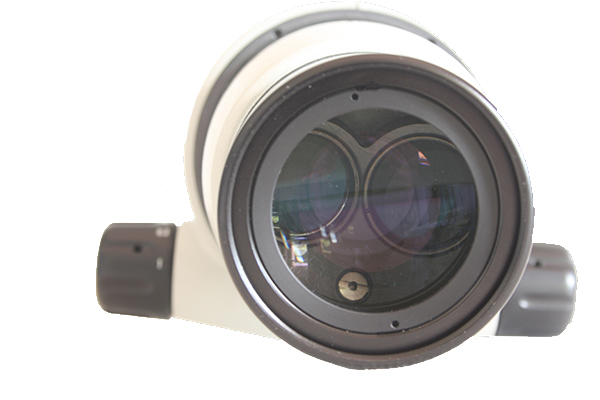
The telescope type system: both beam paths seen from above and below through the main objective.
The quality of the main objective is directly proportional to image quality. To increase image quality, we recommend exchanging the lower-cost plan objective (available as 0.5x, 0.75x, 1x, 1.5x and 2x objectives) with a plan apo objective (0.5x and 1x), since the plan apo has a higher numerical aperture and is thus ideally suited for high-quality photography across the entire zoom range.
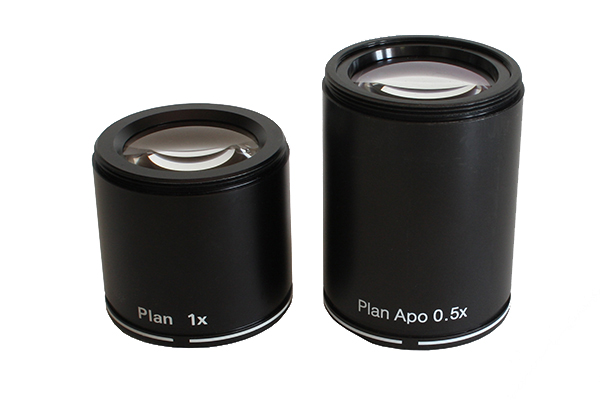
Conclusion:
Nikon’s SMZ 800 is a good fit for photomicrography applications. If the budget allows, we recommend opting for the higher-quality plan apo objectives, since they deliver superlative image quality.
Photography:
Fitting the microscope to digital single-lens reflex (DSLR), mirrorless interchangeable-lens cameras (MILC ), digital single-lens mirrorless (DSLM) or C-mount cameras is easy with our LM digital SLR adapters, which feature a plan achromatic optical system. Our products make it possible to capture top-quality microscope images. To help you select the adapter that is right for your camera, we have set up an online configurator on our website. You can also email us – ideally with attached photographs of your microscope.
Modern DSLR and single-lens mirrorless (DSLM) offer the latest technology and are generally very well suited for microscopy applications. Most of them can be controlled remotely via PC/Mac. Because of their high sales volumes, they offer an excellent price/performance ratio compared to special-purpose microscope cameras.
Features of top DSLR and single-lens mirrorless cameras (DSLM):
- Large, powerful full-frame sensors (36 x 24 mm)
- Sensor resolution of 61 megapixels or 240 megapixels with Pixel Shift technology
- High light sensitivity (ISO 400,000+)
- Extensive dynamic range (up to 15 aperture stops/f-stops)
- Short exposure times (1/8000 second) up to 1/32,000 seconds using the digital shutter
- 4K Ultra HD or 8K Ultra HD video function
- Live video capture on external monitors in ultra HD quality
In most cases, these cameras are significantly more powerful than microscope cameras with smaller sensors (1/2" or 2/3"). On our website you will find our current camera recommendations and a camera ranking which is specifically tailored to microscopy applications.
New LM Digital Adapter for: Sony Alpha 9 III / Nikon Z9 / Nikon Z8 / Sony Alpha 7R V / Sony Alpha 1 II / Sony Alpha 1 / Sony Alpha 9 II (ILCE-9M2) / Sony FX3 Cinema Line / Sony Alpha 9 / Nikon D6 / Canon EOS R3 / Canon EOS R6 Mark II / Canon EOS R8 / Sony Alpha 7R IV / Canon EOS R5 II / Nikon Z6III / Canon EOS R5 / Sony Alpha 7S II / Sony Alpha 7S III / Sony Alpha 7R III / Canon EOS R6 / Nikon Z6 / Nikon Z6II / Sony Alpha 7R II / Nikon Z7 / Nikon Z7II / Canon EOS R / Canon EOS Ra (Astro) / Nikon Z5 / Sony Alpha 7C / Canon EOS RP / Sony Alpha 7S / Canon EOS R7 / Leica SL2-S / Canon EOS R10 / Nikon Z50 II / Canon EOS 1D X Mark III / Nikon Z50 / Nikon Z30 / Nikon Z fc / Nikon D850 / Canon EOS 1D X Mark II / Nikon D780 / Olympus OM-1 / Sony Alpha 7III / Olympus OM-D E-M1 Mark III / Canon EOS R100 / Sony Alpha 6700 / Nikon D5 / Sony Alpha 6600 / Fujifilm X-H2S / Fujifilm X-S10 / Fujifilm X-E4 / Fujifilm X-Pro3 / Olympus OM-D E-M1X / Sony Alpha 6400 / Sony Alpha 6100 / Sony ZV-E10 / Canon EOS 1D X / Nikon D4s / Olympus OM-D E-M5 III / Canon EOS 90D / Canon EOS 5D Mark IV / Nikon D4 / Nikon D750 / Canon EOS 6D Mark II / Fujifilm X-T5 / Fujifilm X-T4 / Fujifilm X-T3 / Sony Alpha 6300 / Sony Alpha 6500 / Nikon D500 / Nikon D810 / Nikon D800 / Canon EOS M6 Mark II / Nikon D800E / Nikon Df / Panasonic Lumix DC-G9 / Nikon D610 / Nikon D600 / Canon EOS 250D / Canon EOS 850D / Rebel T8i / Canon EOS 6D / Sony Alpha 99 II (SLT-A99 II) / Canon EOS M200 / Canon EOS 5DS R ( without low-pass filter) / Olympus OM-D E-M1 Mark II / Canon EOS 80D / Canon EOS M50 Mark II / Canon EOS 5DS / Canon EOS M50 / Sony Alpha 77 II / Canon EOS 70D / Nikon D7200 / Pentax K-1 Mark II / Canon EOS 200D / Canon EOS 800D / Rebel T7i / Canon EOS 77D / Canon EOS 5D Mark III / Canon EOS 60D / Sony Alpha 7R /